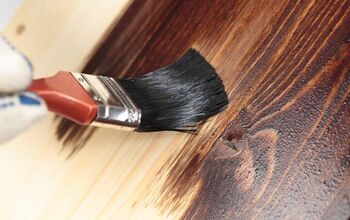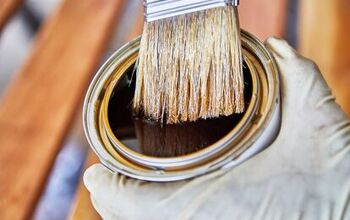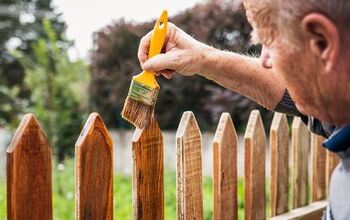Are Wood Stain Fumes Harmful? (Find Out Now!)

Are you are trying to bring life back to an old bookshelf, or working on a backyard deck? If so, the right wood stain can be the difference between a good finish and a great one. Staining wood isn’t a difficult task but it’s important to take steps to be safe during the process.
Wood stain fumes are harmful and can cause vomiting, seizures, and respiratory problems. The fumes are dangerous because wood stains contain dyes, solvents, and binders that are unsafe to breathe. Wood stain fumes can contain volatile organic chemicals (VOCs) such as formaldehyde, arsenic, and benzene that are dangerous and can be deadly.
It’s a good idea to work outside or keep windows and doors open if working indoors. When planning a new work working project, safety is key to a beautifully finished product. Using a fan or two to help blow the fumes away from you and out the window is advised.
Preparing for Water Based Wood Stain
Something to consider when staining wood is whether to use oil-based or water-based stains. Oil-based stains tend to have strong fumes that can make breathing difficult. Water-based stains have fewer fumes and are generally more eco-friendly.
When time is an issue, it’s important to know which wood stains dry quicker. Water-based wood stains will dry faster than oil-based stains. Oil-based stains, however, tend to last longer than water-based stains and are more resilient to weather and touching.
Before applying wood stain, whether water or oil-based, sanding is important. If you don’t sand the wood, the result may not be what you want.
Steps to Prepare Wood (For Water-Based Wood Stains on Raw Wood Projects)
- Sand the wood with either 120-grit sandpaper.
- Carefully remove all dust with a shop vac, a water-dampened, oil-free cloth.
- Dampen the wood lightly to reduce grain rise after sanding.
- Sand (when dry) with a 220-grit or higher, foam sanding pad.
Wood Preparation Steps (For Water-Based Stains on an Existing Finish)
- Use steel wool or a scrub pad along with denatured alcohol to clean.
- Allow 2 hours to dry.
- Sand with 220-grit or higher foam sanding sponge.
- Carefully remove all dust with a shop vac, a water-dampened, oil-free cloth.
- Allow a 2-hour dry time prior to applying the wood stain.
- Apply water-based stain with a cloth, sponge, or paintbrush.
- Allow at least 2-hours of dry time before applying the second coat.
*Dry times can vary depending on the temperature, whether the project is indoors or outdoors, and humidity level. It can also differ depending on the thickness of the coat of wood stain used.
Preparing for Oil Based Wood Stain
Oil-based wood stain takes a little more preparation than water-based wood stain. The fumes in oil-based stains require proper air circulation, and it is often best to stain outdoors when possible. If an outdoor location is not viable, open windows and use fans to blow the fumes outside.
Steps to Prepare Wood (For Oil-Based Wood Stains on Raw Wood Projects)
- Sand the wood with 120-grit sandpaper.
- Use a shop vac or a lightly dampened, oil-free cloth to remove dust.
- Sand with a 220-grit sanding sponge to smooth.
- Carefully remove all dust with a shop vac or oil-free, dampened cloth.
- Apply stain with a paintbrush, cloth, or sponge.
- Allow 24 hours to dry before applying the second coat.
Oil-based stains tend to dry slower than water-based wood stains. In warmer temperatures, it can take, on average, eight hours or longer to dry. In cold climates, it can take 24-hours or longer. During the process of using wood stains, especially oil-based wood stains, remember to maintain proper ventilation.
Personal Protective Gear When Staining Wood
We know that the fumes can be toxic, especially when using stain indoors. On top of ensuring proper air circulation, it’s important to protect yourself in other ways. What you wear matters.
- Wear safety goggles to protect your eyes.
- Old clothing is essential when working with stains.
- Wear gloves to keep solvents and stain off your hands. Nitrile gloves tend to work better than latex for skin protection.
When you finish working with the wood stain, be sure to wash the stain from your hands and clean up the work area.
Dangerous Ingredients Found in Wood Stains
Wood stains may have many harmful ingredients. These can include the following:
- Sodium Hydroxide and other Corrosives
- Alcohol
- Glycol Ether (ethylene glycol, propylene glycol)
- Alkanes (methane, ethane, propane, and others)
- Cyclic Alkanes (Hydrocarbons with a ring-like structure)
The hydrocarbons in wood stains can be extremely harmful when inhaled.
Poisoning from Ingesting Wood Stain
While wood stain fumes can be toxic when inhaled, you also need to watch out for poisoning due to ingesting the product. Wood stain poisoning can occur when someone inhales fumes or swallows wood stains. Here are the symptoms to watch out for if poisoning is suspected.
Stomach
- Diarrhea
- Nausea
- Vomiting
- Abdominal Pain
- Blood in Stool
- Esophageal Burning
Ears, Eyes and Throat
- Pain and/or burning in ears or eyes
- Pain or burning on face or lips
- Loss of vision
- Throat pain
Lungs
- Swollen throat
- Breathing difficulty from fumes
Skin
- Rash or red skin
- Burns
Nervous System
- Nervous Feeling/Acting Nervous
- Dizziness
- Memory Loss
- Confusion
- Difficulty Focusing
If you have inhaled wood stain fumes, it is vital to move to an area with fresh air immediately. If the wood stain has been ingested, contact 911 or the local poison control center.
You can contact the Poison Control Center in the United States at 1-800-222-1222. Agents with the Poison Control Center can advise you on steps to take. The Poison Control Center is open 24-hours a day, 7 days a week for calls.
Before calling, you need to know the type of wood stain used and have a list of the ingredients. You also need to know how much was ingested or how long the person was subjected to fumes. The height, weight, and age of the person are also necessary for the poison control center or 911 to assess the situation.
Health Risks
It is important to take the wood stain can or ingredient list to the hospital. At the hospital, tests may be performed to help determine the severity of the wood stain poisoning. These tests may include:
- Chest X-Ray
- Endoscopy (To check the esophagus for damage)
- Bronchoscopy (To check airways for burns or damage)
The emergency room physician may give you fluids through an IV or other medicines to treat symptoms. A breathing treatment with Albuterol may be used for less severe cases. A ventilator (a machine that breathes for a patient) may be ordered for more severe cases.
The hospital may also do skin irrigation every couple of hours to ensure all solvents are removed from the skin. For severe burns from the wood stain, surgery may be necessary to remove skin that is burned or to remove damaged cells inside the body.
While many people will fully recover from wood stain fume damage or from ingesting wood stains, others may experience infections, long-term breathing difficulties, and even death.
Effects
Inhalation can cause dizziness, nausea, and headache. If a person is suspected of inhaling wood stains and is experiencing any of the following, it is important to seek medical attention quickly.
- Passing out
- Vomiting
- Confusion
- Seizures
Ensuring that there is plenty of ventilation when using wood stains is important for safety.
Related Questions
How long will wood-stain fumes linger?
In general, it can take up to eight hours or longer for wood stain fumes to exit. Until the fumes are gone, it is important to keep the air circulating with open windows, fans, or air purifiers. Water-based stains offer fewer fumes than oil-based products.
Can wood stain fumes ignite?
Wood stain fumes can ignite when if there is a pilot light or open flame nearby. Fresh wood stain fumes are more likely to ignite than if the stain has been drying for a while. Well-ventilated rooms are much safer and reduce the risk of wood stain fumes igniting as the stain dries.
How long does it take for the wood stain to dry?
Most traditional wood stains recommend dry times of 18 to 24 hours. Some new wood stains have fast drying times which allow for recoating in one day. Once you recoat, it is a good idea to wait at least 24 hours for the project to dry.
Wrapping Up
Wood stain fumes can be damaging to your health. There are ways to prevent these dangers to your health. Taking precautions by wearing protective clothing is a good start for safely staining wood.
As we have discussed, it is important to take steps to ensure proper airflow when using wood stains. It is also important to keep flames away from wood stains and soak all cloths in water prior to disposal. To help dispel the fumes quicker, you can use multiple fans to blow the fumes out the windows and doors.
The best way to prevent wood stain fume damage is to choose one that does not contain volatile organic chemicals.

We are a team of passionate homeowners, home improvement pros, and DIY enthusiasts who enjoy sharing home improvement, housekeeping, decorating, and more with other homeowners! Whether you're looking for a step-by-step guide on fixing an appliance or the cost of installing a fence, we've here to help.
More by Upgraded Home Team

















![How To Reset A Whirlpool Cabrio Washer [In 5 Easy Steps!]](https://cdn-fastly.upgradedhome.com/media/2023/07/31/9076531/how-to-reset-a-whirlpool-cabrio-washer-in-5-easy-steps.jpg?size=350x220)
![12 Washing Machine Brands to Avoid [with Recall Data]](https://cdn-fastly.upgradedhome.com/media/2023/07/31/9075781/12-washing-machine-brands-to-avoid-with-recall-data.jpg?size=350x220)








